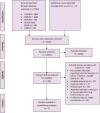Cervical dilatation patterns of 'low-risk' women with spontaneous labour and normal perinatal outcomes: a systematic review
- PMID: 28892266
- PMCID: PMC6033146
- DOI: 10.1111/1471-0528.14930
Cervical dilatation patterns of 'low-risk' women with spontaneous labour and normal perinatal outcomes: a systematic review
Abstract
Background: The call for women-centred approaches to reduce labour interventions, particularly primary caesarean section, has renewed an interest in gaining a better understanding of natural labour progression.
Objective: To synthesise available data on the cervical dilatation patterns during spontaneous labour of 'low-risk' women with normal perinatal outcomes.
Search strategy: PubMed, EMBASE, CINAHL, POPLINE, Global Health Library, and reference lists of eligible studies.
Selection criteria: Observational studies and other study designs.
Data collection and analysis: Two authors extracted data on: maternal characteristics; labour interventions; the duration of labour centimetre by centimetre; and the duration of labour from dilatation at admission through to 10 cm. We pooled data across studies using weighted medians and employed the Bootstrap-t method to generate the corresponding confidence bounds.
Main results: Seven observational studies describing labour patterns for 99 971 women met our inclusion criteria. The median time to advance by 1 cm in nulliparous women was longer than 1 hour until a dilatation of 5 cm was reached, with markedly rapid progress after 6 cm. Similar labour progression patterns were observed in parous women. The 95th percentiles for both parity groups suggest that it was not uncommon for some women to reach 10 cm, despite dilatation rates that were much slower than the 1-cm/hour threshold for most part of their first stage of labours.
Conclusion: An expectation of a minimum cervical dilatation threshold of 1 cm/hour throughout the first stage of labour is unrealistic for most healthy nulliparous and parous women. Our findings call into question the universal application of clinical standards that are conceptually based on an expectation of linear labour progress in all women.
Funding: UNDP/UNFPA/UNICEF/WHO/World Bank Special Programme of Research, Development and Research Training in Human Reproduction (HRP), Department of Reproductive Health and Research, World Health Organization, and the United States Agency for International Development (USAID).
Tweetable abstract: Cervical dilatation threshold of 1 cm/hour throughout labour is unrealistic for most women, regardless of parity.
Keywords: Cervical dilatation; first-stage labour; labour curve; labour dystocia; labour progression; spontaneous labour.
© 2017 World Health Organization; licensed by John Wiley & Sons Ltd on behalf of Royal College of Obstetricians and Gynaecologists.
Comment in
-
The physiologic pattern of normal labour progression.BJOG. 2018 Jul;125(8):955. doi: 10.1111/1471-0528.14929. Epub 2017 Nov 3. BJOG. 2018. PMID: 28889657 No abstract available.
References
-
- Friedman E. The graphic analysis of labor. Am J Obstet Gynecol 1954;68:1568–75. - PubMed
-
- Friedman EA. Primigravid labor; a graphicostatistical analysis. Obstet Gynecol 1955;6:567–89. - PubMed
-
- Friedman EA. Labor in multiparas; a graphicostatistical analysis. Obstet Gynecol 1956;8:691–703. - PubMed
-
- Friedman EA, Sachtleben MR. Dysfunctional labor. II. Protracted active‐phase dilatation in the nullipara. Obstet Gynecol 1961;17:566–78. - PubMed
-
- Friedman EA, Sachtleben MR. Dysfunctional labor. I. Prolonged latent phase in the nullipara. Obstet Gynecol 1961;17:135–48. - PubMed
Publication types
MeSH terms
Grants and funding
LinkOut - more resources
Full Text Sources
Other Literature Sources
Miscellaneous


